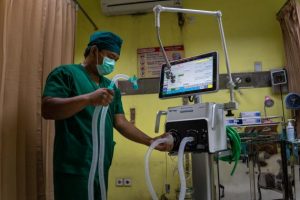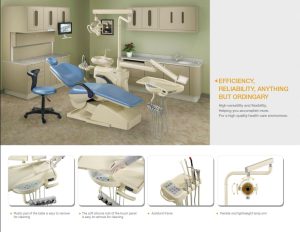Accident & Emergency Equipment
Accident & Emergency Equipment
These are equipment used in the accident and emergency department, mostly known as life saving equipment
Bag valve mask
It is a device used to manually give oxygen to patient who are unable to breathing or breathing inadequately, comes in different sizes.
It is placed on the patient face and gentle squeezed by the paramedic allowing oxygen to flow into the patient’s lungs.
Suction Unit:
A device used to suck secretions and fluids from a patient’s airway which may obstruct the patient’s airway causing severe respiration complication,
A sterile catheter is attached by surgical tubing to the suction unit which generates suction so that the secretion can be suctioned from the patient’s airways and collected in a container attached to the unit.

ECG Monitor with Defibrillator:
The main function of the ECG monitor is to display the patient’s ECG on the build-in scree so that it can be monitored by the paramedic.
Defibrillator it is used to shock cardiac arrhythmias, it basically “stun” the heart so that the heart’s normal electrical impulse can make the heart beat normally.

Incubator:
They are used to keep neonates warm while being transported in the ambulance, it provides a warm and safe environment for the neonate.

Ventilators:
It is a device designed to mechanically move air into the lungs of a patient who is not breathing or breathing or breathing inadequately,
the different between a ventilator and a bag valve mask is that a bag valve mask is manually operated while ventilator is a machine that is automatically operated.
an oxygen cylinder is connected to the ventilator to provide oxygen.

Infusion pump & Syringe drivers:
A device that control the rate at which an infusion is infused to a patient, it is used when a patient is being transported from one hospital to another.

syringe pump it is a device that controls how much fluid from a drip flows to the patient, the rate and the amount of fluid delivered through the device are controlled by changing the settings on the device.

Heamogulcometer:
it is used to check a client’s blood glucose level, a small drop of the client’s blood is dropped onto a disposable strip which is inserted into the monitor and the client’s blood glucose level is assessed and displayed on the monitors screens.
Cervical collar:
Also known as neck brace, an adjustable collar which is placed around the neck of patients who have a suspected head or neck injury to minimize head and neck movement which could worsen the injury.
Trauma/Spinal board:
it is unpadded patient- handling catty stretchers used to provide rigid support to patients who have suspected spinal injuries, can be used in conjunction with a spider harness and head blocks to secure the patient to the board, they can be used to carry ant patient over.
Medication bag:
A small bag that is used to carry the medications that paramedics may need to administer to patient the bags are padded to protect the ampules in the bags, the meds are kept in individual pouches or under elastic straps,

Jump bag:
It is a bag used to carry most of the surgical sundries which includes bandages, drips, syringes et cetra
Conclusion: These equipment are some of the many pieces of specialized medical equipment but they play an important role although they might sound basic, paramedics receive training on how to use the equipment during their studies.





